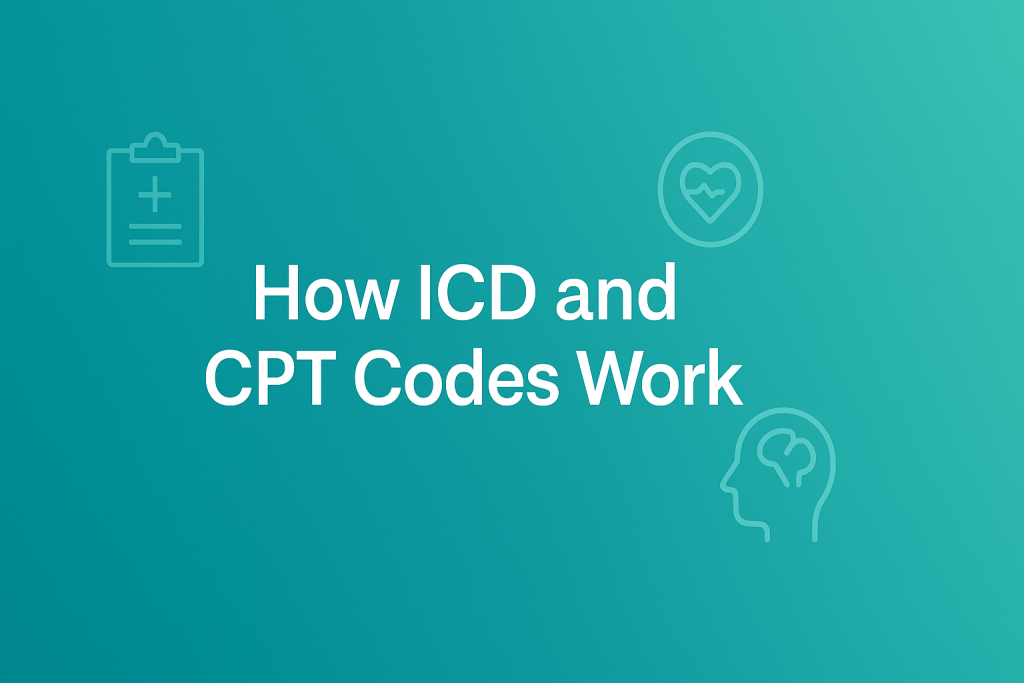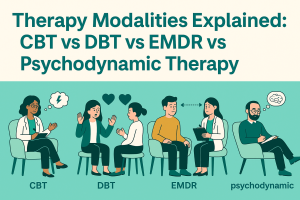Why Understanding Medical Codes Matters for Your Practice
In the complex world of healthcare billing, ICD and CPT codes form the essential language that connects clinical care with appropriate reimbursement. While often mentioned together, these coding systems serve distinctly different purposes that every healthcare provider must understand. Getting them right means cleaner claims, faster payments, and fewer compliance headaches.
Having optimized medical practice websites for over a decade, I've seen how proper coding education directly impacts a clinic's financial health. In this comprehensive guide, we'll break down how ICD and CPT codes are different, explore why each is critically important, and provide practical strategies to implement this knowledge effectively in your practice. By the end, you'll have a crystal-clear understanding of how these coding systems work together to accurately tell the story of patient care.
ICD vs CPT Codes: The Fundamental Differences
At their core, ICD and CPT codes serve different masters in the healthcare ecosystem. Think of them as two different languages that, when used together, create a complete picture of a patient encounter.
Key Takeaway
ICD codes explain why treatment was necessary, while CPT codes describe what specific service was performed. This fundamental distinction forms the foundation of accurate medical billing.
What are ICD Codes? (The "Why" Behind Treatment)
ICD codes (International Classification of Diseases) represent the diagnosis side of the equation. These codes describe the patient's condition, symptoms, or reason for seeking care - essentially establishing medical necessity for services provided.
The World Health Organization (WHO) maintains ICD codes for global use, making them a universal standard for tracking health and disease trends across countries. In my experience working with therapy practices, I've found that many billing issues stem from insufficient specificity in ICD coding rather than problems with procedure coding.
ICD-10-CM Code Example
I63.31 - Cerebral infarction due to thrombosis of right carotid artery
This code specifies not just the condition (cerebral infarction) but also the cause (thrombosis) and location (right carotid artery).
What are CPT Codes? (The "What" of Services Provided)
CPT codes (Current Procedural Terminology) tell the other half of the story by describing the specific services, procedures, and treatments provided to patients.
The American Medical Association (AMA) developed and maintains CPT codes, which serve as the standard procedural language across U.S. healthcare, from federal programs like Medicare to private insurers. Through my work analyzing billing patterns, I've observed that practices who regularly update their CPT code knowledge typically experience 15-30% fewer claim denials.
CPT Code Example
97110 - Therapeutic procedure to improve range of motion and muscle strength
This code specifically describes a therapeutic exercise session focused on improving mobility and strength. This same system is used to report specialized services like EMDR therapy.
Side-by-Side Comparison
| Feature | ICD Codes | CPT Codes |
|---|---|---|
| Primary Purpose | Describe diagnosis/medical necessity | Describe procedures/services |
| Managing Organization | World Health Organization (WHO) | American Medical Association (AMA) |
| Update Frequency | Every 1-4 years (minor updates) | Several times annually |
| Code Format | Alphanumeric (3-7 characters) | Primarily 5-digit numeric |
| Role in Billing | Establishes "why" treatment was needed | Establishes "what" service was provided |
Why These Coding Systems Matter in Healthcare
Understanding the differences between ICD and CPT codes is more than an academic exercise - it directly impacts your practice's operations, compliance, and financial health.
The Financial Impact: Clean Claims and Proper Reimbursement
These coding systems form the foundation of the healthcare revenue cycle. When used correctly, they ensure your practice receives appropriate and timely reimbursement for services rendered.
Consider this: one analysis found that over 30% of claim denials occur partly due to incorrect coding. From my consulting experience, I've helped practices recover significant revenue simply by addressing common coding errors that they didn't even realize were happening. The connection between specific diagnoses and procedures must be clear and defensible.
Operational Efficiency: Streamlining Practice Workflows
Standardized coding creates efficiency across your practice operations. When everyone uses the same coding language, it reduces confusion, minimizes back-and-forth communication, and accelerates claims processing.
I've implemented coding systems where we reduced billing-related administrative time by up to 40% simply by creating clearer coding protocols and reference materials for clinical staff. This standardized approach also makes staff training more straightforward and effective.
Compliance and Risk Management
Proper coding isn't just about revenue - it's also about maintaining compliance with regulatory requirements. HIPAA designates both CPT and ICD codes as standard sets for electronic healthcare transactions.
Regular coding audits I've conducted often reveal that practices using outdated or incorrect codes face not only financial risks but also compliance exposure. Staying current with annual code updates is essential for both maximizing reimbursement and minimizing audit risks.
Current Coding Updates: What's New for 2025
Staying current with coding changes is essential for maintaining compliance and maximizing reimbursement. Here are key updates that took effect in 2025.
ICD-11 Implementation Progress
The transition to ICD-11 represents a significant evolution in diagnostic coding. While ICD-10-CM remains in effect for now, the healthcare industry continues moving toward full ICD-11 implementation. This updated classification includes expanded codes for rare diseases, more comprehensive mental health disorder classifications for conditions like Schizophrenia and PTSD, and allows for greater specificity on diagnoses like Alexithymia and Anxiety. The expanded focus on psychological health also aids in documenting issues like repressed emotions and personality traits identified in the Neuroticism Test, alongside the incorporation of modern medical knowledge, particularly in genomics and precision medicine.
Common Coding Challenges and Solutions
Even experienced practitioners encounter coding challenges. Here are solutions to common problems I've addressed with therapy practices.
Establishing Medical Necessity
The connection between ICD and CPT codes must clearly demonstrate why a specific procedure was medically necessary for a particular diagnosis. This linkage forms the foundation of defensible billing.
Solution: Document the logical clinical relationship between diagnosis and treatment. For example, when using ICD-10 code M54.2 (Cervicalgia) with CPT code 97140 (Manual therapy), your documentation should explain how manual therapy addresses the specific cervicalgia symptoms.
Navigating Specificity Requirements
ICD-10 codes often require significant specificity, which many practitioners find challenging. Insufficient specificity represents one of the most common reasons for claim denials.
Solution: Implement a documentation checklist (e.g., DAP Notes) that prompts for all required elements. For conditions like strokes, this means specifying laterality (right/left), vessel involvement, and encounter type (initial/subsequent/sequela).
Managing Annual Updates
With CPT codes updating several times yearly and ICD codes changing annually, staying current presents an ongoing challenge.
Solution: Create a systematic update process including:
- Designated staff member responsible for monitoring changes
- Quarterly coding education sessions
- Regular updates to your electronic health record system
- Pre-implementation testing of new codes
Optimize Your Medical Coding Today
Streamline your billing process, reduce claim denials, and maximize reimbursement with our comprehensive coding resources designed specifically for therapy practices.
Explore Practice Management SolutionsFrequently Asked Questions
What happens if I use the wrong ICD or CPT code?
Using incorrect codes can lead to claim denials, delayed payments, compliance issues, and potential audit risks. In some cases, it may be considered fraud if done intentionally. Always verify codes before claim submission and implement regular audits to catch errors proactively.
How often do ICD and CPT codes change?
CPT codes update several times each year to reflect new medical services, with major updates effective January 1. ICD codes typically receive minor updates every 1-4 years, with major revisions occurring less frequently.
Can one patient encounter have multiple ICD and CPT codes?
Yes, it's common for a single encounter to involve multiple codes. A patient might have several diagnoses (ICD codes) and receive multiple services (CPT codes) during one visit. The key is ensuring each procedure code links appropriately to a diagnosis that justifies medical necessity.
Who creates and maintains CPT codes?
The American Medical Association (AMA) develops and maintains CPT codes through its CPT Editorial Panel, which includes representatives from various medical specialties and healthcare organizations.
Next Steps for Your Practice
Understanding how ICD and CPT codes are different and why each is important represents a foundational element of practice management. By implementing the strategies outlined in this guide, you can improve claim accuracy, reduce denials, and ensure proper reimbursement for services rendered.
The most successful practices view coding not as an administrative burden but as a critical clinical and financial function. They invest in ongoing education, leverage technology appropriately, and maintain proactive compliance monitoring.
If you're looking to optimize your coding processes further, consider conducting a comprehensive coding audit, updating your practice management system, or implementing specialized staff training. These investments typically yield significant returns through improved reimbursement and reduced administrative costs.
For additional resources or to share your coding experiences, visit our Practice Management section at TherapyDial.com. Our team continuously updates materials to reflect the latest coding changes and best practices.
TherapyDial Editorial Team
This article was reviewed and updated by the TherapyDial Editorial Team. Our content follows strict editorial guidelines to ensure accuracy, relevance, and timeliness. We regularly monitor coding updates and practice management trends to provide our readers with the most reliable information.




